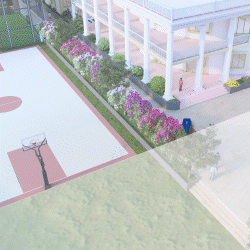Baa, Gunkesari is blooming
We use Google Cloud Translation Services. Google requires we provide the following disclaimer relating to use of this service:
This service may contain translations powered by Google. Google disclaims all warranties related to the translations, expressed or implied, including any warranties of accuracy, reliability, and any implied warranties of merchantability, fitness for a particular purpose, and noninfringement.


Ba's face was full of smiles as he walked into the ICU with his old man holding a cane with wrinkled hands. After a short stay in the ICU, when we came out, we looked at the tear-stained faces. His face was not smiling, nor was it juicy.


It looked completely juiceless, like a squeezed lemon. Showing his trembling hands, he said, 'Rajan will not live long now.
2072 year Baisakh 30-31. After looking at the health status of my sister Rajan, who was being treated at Alka Hospital in Lalitpur, Ba said, 'What to do!
The ancestors used to say that a person who stinks does not live long. There may be some truth. However, Rajan dai survived despite being grunted. Ba said neither ghur ghanhai, nor suffered from any serious illness, on the morning before the fall of 2075, he merged forever into panchatva.
...
I had a wish - to plant Gunkesari flowers, at home, in pots. Botanist Dr. I was more drawn to Gunkesari because I read the works written by Tirtha Bahadur Shrestha connecting Gunkesari and the culture and civilization of Kathmandu. I didn't see it, Gunkesari. I used to ask the Raithanes of Kathmandu, about that flower mentioned in the famous poem 'Alkapuri Kantipuri Nagari' by Adicavi Bhanubhakta Acharya. was memorized,
'Chapala, Avalharu Ek Surama
Gunkesariko Phool Lee Shirma
Hidnya Sakhi Leekan around
Alkapuri Kantipuri Nagri'
Aha! I could not find any information about that lustless but full of beauty-power flower within the limits of anyone's identity. Some people used to say, 'This is a flower that the elites grow in their garden. Earlier they were found in the gardens of Rana and Rajas. Now this flower doesn't look so easy.' So much neglect-performance!
One day, the Guvo of Gunkesari entered my house, like the arrival of the monsoon after a long drought. I transplanted the Guvo of Gunkesari, which has the ability to grow and flower even in a pot, into a sasneh pot. Add fertilizer. Growing up slowly. I was curious - when will it bloom? What will its appearance be? What are its wings like?
sorry! When I was growing buds on the Gunkesari flower that I had planted. He seemed to be engaged in blooming exercises. At that time, my father made this earth 'baibai' forever.
...
Mera Ba Dhami. My ba jhankri. My father is a doctor. My father is a social worker. My father is active in government service. There are many introductions. My father is a farmer. My father leader. My father is a craftsman. Mera Ba Shloka-Vachach. There are several introductions.
When Baka's face appears in front of me, I think, 'Which identity should I beautify him with?' What can we say, it's like saying. Able to perform multiple roles. Beautiful and attractive like a nightshade that grows towards the wall in everyone's eyes. He was of a nature to never show his eyes.
Bale used to see medicinal properties and elements in every weed and plant around the house, every plant and plant in the forest. Since childhood, I traveled Vijayachhap-Sindhuli Madi, carried on my father's shoulders. About 3-4 hours. When he reached the Sindhuli Garhi area, Ba would identify the local herbs and say, 'Yo Pakhanbhed, this Gurjo, this Asuro, this Nim, this Burro. It cures this disease, it cures this disease...'
How much medicinal knowledge! He was always biting. It was always in the pocket. If someone was bleeding, they would grind it and eat it. If any child gets sick, they are completely healthy after a few minutes of puffing. Jokhana was equally well looked after. Especially, he used to put half a handful of rice in a brass plate and move it around, right and left. As if a certain doctor had 'diagnosed' the disease, he would say, 'It has been applied. One chicken chick should be vowed.'
Basically, during the rainy season, most of the villagers were tormented by jand pilo. When someone got sick, the same treatment method was followed. No emergency time, no health center, no medical facility. In the village, the pillow came only occasionally. A female relative's very "sensitive parts" used to be attacked by pillows, every year. No shame, no shame! Treatment is treatment! Bale used to grind the wheels, green duwo and raw rice growing towards the lake and spread it around the yellowed land. The pillow will be eaten in two days!
Who knows such medicinal knowledge?
...
Meat was often cooked at home. However, in August and March, meat was not eaten. Locals used to take vows to Koshipari (the area of Sunkoshi Parika including Ramechhap). The name was - 'Koshipare Pooja'. Males and females of the local species raised as a vow to Koshipare were kept, making a temporary shrine near the house. Some would bring a snake and some cooked meat. August and Chait used to register as the season for us to eat Raithane chicken.
During Dasain, Saune Sankranti, Maghe Sankranti, the house used to eat meat in buckets. He always lived in Zamani, Ba. "Zamani Bhaag" used to be a pile of meat in the house. Alo meat was dried all over the load on the angeno. Meat was cooked in the kitchen for weeks. This happened. Sometimes the cow-worship, Satyanas of the rooster! Sometimes Kulo's fountain-worship, the rooster's Satyanas! Sometimes Sunday worship, chicken and egg Satyanash! Sometimes worship at the shrine, Boko Swaha! When Vaishakhe Purnima Puja, Pathi Nimityann !
...
Love for children is immense. Once, while going down from the village to Sindhuli Madi during the rainy season, he saw mushrooms growing all over the forest after reaching some distance. It was probably the Kalunge mushroom. Ba picked about a bag of mushrooms and returned home with them.
After leaving the mushrooms at home, Ba again went to Sindhuli Madi. At that time there was a village (Vijaychap) and Sindhuli Madi. Farming on both sides. Ba's youth life was spent sometimes in the village and sometimes in the Madi.
...
Ba Valuvajor, Simful (both Ramechhap), Kathmandu, Vijayachhap, Boze (Sindhuli) and finally Kathmandu. These are the places that Bale spent in his life while covering eight decades of journey. A lot of time was spent in Vijayachap. For almost three decades. He stayed with me in Kathmandu for two months around the year 2056. We lived in a ghost bungalow in Dillibazar, at that time. One day, after returning to the room, he said, 'Nani, today I met the housekeeper from when we were living in Kathmandu! That doll is sitting on the road. Both the old and the old have stayed.'
During the years 2018-19, when he was in the traffic service, his parents lived with a tent on Putlisadak. However, after her stay in Kathmandu was not healthy for her mother, she returned to the village. What was the population density and house density in Kathmandu at that time? Ba found Gharveti after three and a half decades. Equally forward in
public relations. Ba started living with us since 2064 when he was living in the forest. There were no strangers from the village. He used to greet his peers or younger people with 'Namaste' by joining both hands. Be it a famous person or just a normal Jimmy. He showed equal respect and reverence to everyone, from the heart. Perhaps the 'eraser' had erased the arrogance, arrogance and anger in him.
...
Ba used to say, 'When King Mahendra went to the east in fourteen years, I also went with him.' At that time Ba was in the Nepalese army. Later, he moved to the traffic service of Nepal Police. Lately, he used to say, 'I was once in toffee.' I thought 'toffee' was a cooperative term. Recently, I understand that 'toffee' means 'traffic'. Similarly, around the year 2070, one day Ba said, 'Father! Govinde is kept on ice!'
While searching for the meaning of keeping Govinda's uncle on 'ice', I guessed, 'He has passed away and must have been kept on 'ice'! Because when a person dies, the body is kept on ice so that it does not burn.' I was heartbroken, 'Jya Hai..., Govind Kaka has also passed away.' Then I was sure, "Uncle Govind is no more."
...
After Baa's physical existence ended, two things remained with me. They are – radio and clock. Radio and Mera Ba are like synonyms. As far as I can remember, I have never lost my affinity with the radio. Radio when you sleep, radio when you wake up. Radio even when going to a fair. A radio on the shoulder even when you are in doubt. Radio every moment. At that time, a license was required to play radio. Permission to keep a radio in the house was given only after the approval of the Zilla Panchayat. Otherwise illegal. A license was made by Bale. He used to repeat Vijayachhap-Sindhuli Madi over and over with the same license inside the shell sewn for the radio.
Ba's daily routine started at 5:30 in the morning. Five minutes before five o'clock, when Radio Nepal started playing 'Syan' in a loud voice, Ba would open the bottom of the radio. Then the first tune was played. He used to listen to morning hymns, news, songs and plays. However, twice a day, the radio got a break. One when the English news comes on and the other when classical tunes play. Perhaps, because of his lack of access to the English language and the monotony of classical tunes, both of those broadcasts never pleased Ba.
My radio has not been on since the morning of October 24, 2075, the day before that Ba turned on the radio for the last time, early in the morning. Before five o'clock. Even now, it is five in the morning every day. However, the radio does not play now. It is in the middle of being a silent spectator on the drawer.
...
Ba passed away, five years ago. Precisely at the time of budding of Gunkesari. I used to think, 'Bailey, how can we be bye-bye so soon! May you live for a few more years. Until the century.'
passed but.... Gunkesaris are still blooming even after the
. Every year around August, Guvo is blooming. When I look at Gunkesari flowers, I see my own reflections in those flowers.
As pure as the water of a mountain stream. It seems that people's lives are not different from these flowers, absolutely. Sometimes they bloom with joy, slowly fade away and finally dry up and count the last steps of their lives.'
 प्रकाशित : चैत्र २४, २०८० १०:२३
प्रकाशित : चैत्र २४, २०८० १०:२३

 २३.१२°C काठमाडौं
२३.१२°C काठमाडौं


















